
Most marketing strategies begin with a few things: content, products… and social media.
While using social media isn’t required to grow a business, it can certainly help in most cases. An overwhelming 92% of marketers in 2014 reported that they place high value on social media.
In the modern marketing landscape, social media allows you to reach almost anyone, no matter what niche your business is in.
But just because marketers recognize the importance of social media doesn’t mean they know how to use it effectively.
Many spend several hours a week on it to get just a little return on investment (ROI).
Statista sent out a survey to find out how much time per week marketers spend on social media:

As you can see, more and more marketers are spending large amounts of time on social media (16+ hours per week) each year.
It’s not just marketers either—CEOs do it as well. Another survey found that 43% of CEOs spend more than 6 hours per week on social media.

CEOs and marketers wouldn’t spend this much time on social media, week after week, year after year, unless it produced results.
And it does.
But… don’t you think that a CEO might have better things to do than send out Tweets and “like” posts on Facebook? I do.
I can’t justify spending more than 6 hours a week on social media—the ROI just isn’t good enough.
And yet, I still utilize social media to drive traffic to my blog posts and guest posts. I just don’t spend more time than necessary.
In this post, I’m going to share with you 6 different ways you can save time on social media so that you can focus on more important parts of your business.
Here we go…
1. Batching always wins
The best marketers, SEOs, entrepreneurs, and writers that I know all work in batches.
Batching is a “productivity hack” that has been used for many years by businesses to improve efficiency in a variety of ways.
The premise is simple:
Instead of doing a task at frequent regular or sporadic intervals, do it all at once over a longer period of time (e.g., a week or a month). The longer the time period, the more of a boost in productivity you’ll get.
It helps because of these 3 main reasons:
- It reduces transition time – Whenever you begin a task, it takes you a few seconds or minutes to figure out where you stand, what you need to do, and how you’ll start. When batching, you only focus on doing one task, so you eliminate all subsequent transition time wastage.
- It simplifies things – Switching among many tasks throughout the day is exhausting. When you know you only have a few main tasks to do in a day (in larger batches, of course), it’s less intimidating.
- You can work faster – Switching among many tasks means you have to change your focus multiple times. Every time you switch your focus, you lose any momentum you’ve built up. You can never get “in the zone.”
The one final benefit of batching is that it makes it more difficult to miss things. Batching allows you to schedule ahead so that you won’t forget to do something important. In this case, it’s a social media or blog post.
There are a few ways that you can use batching to save time when it comes to social media.
Way #1 – Come up with post ideas all at once: I recommend coming up with as many social media post ideas as you can (same goes for blog post ideas as well).
Your goal is to build a massive reservoir of social media post ideas that you can draw from as necessary.
How do you come up with ideas?
Well, it will depend on which social networks you want to focus your time on (more on that shortly).

Your blog posts are an obvious source of content—that’s how you’re going to drive traffic back to your blog.
Besides your own material, you want to share other things that your readers would be interested in.
Here are some detailed guides on how to come up with post ideas:
- Stop Guessing: Here’s a Social Media Strategy That Works
- 26 Creative Ways to Publish Social Media Updates
- 100 Killer Ideas For Your Social Media Content
Way #2 – Schedule posts on a regular basis: One of the biggest ways that marketers waste time on social media is logging into each network and posting an update one at a time.
You can save a ton of time by designating one time at the start of the week or month to schedule all your posts. Of course, if something special comes up, you can make small adjustments throughout the week or month.
You should plan to share each blog post you publish at least once:

When you’re scheduling shares for the upcoming week or month, prepare and incorporate posts for any new blog post you will be publishing.
I really like CoSchedule’s basic sharing template for blog posts:

Way #3 – Only work on social media at specified times: Another trap that marketers often fall into is constantly checking their social media accounts for updates. You can waste a ton of time doing this and produce very little in the way of tangible results.
Social media is a lot like email. It’s tempting to check it often to see if you got anything new. But you need to approach it in a disciplined way.
Dedicate one or two periods of the day, 10-15 minutes each, to checking and replying to important posts and messages on social media. You’d be surprised to see what you can accomplish when you put strict limits in place.
Some of you might counter by saying that 42% of people expect a response on social media within 60 minutes of them contacting customer support.
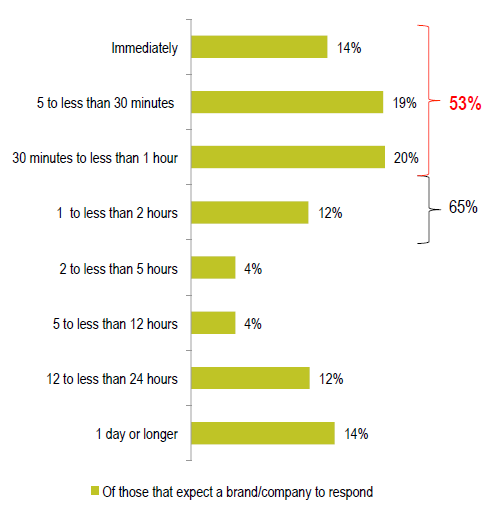
If you’re at the point where you’re constantly getting support requests on social media, you should be able to hire someone to take care of it for you. Don’t waste your valuable time on a simple activity that could be done by almost anyone. Have them alert you if there is something you need to respond to personally.
2. Understand what you’re trying to accomplish
Social media is a time killer for the general population, but when you’re using it for business, it shouldn’t be.
When you log into Twitter, Facebook, or whichever network(s) you use, you shouldn’t be scrolling through a feed of updates just to see what’s new. Your social media activity should be for one purpose.
What is the purpose of your social media presence?
Are you trying to gain followers? While it depends on the specific network, the general rule for gaining followers on social media is to follow people first (a portion will follow back) and post interesting content so that they don’t unfollow you later.
This is typically the main goal of any company that has brand new social media accounts.
While it sounds a bit cynical, you can accomplish this goal without paying any attention to your “feed” or followers for now.
Furthermore, if you batch your post ideas once per week or month and use tools to help you follow people quickly, you can accomplish your task in under 10 minutes a day.
Here are the guides I’ve shared before that will help you get more followers on different networks, starting with Facebook:
Get more followers on LinkedIn:
Get more followers on Pinterest:
Get more followers on Instagram:
Are you trying to drive traffic and leads? Probably the most common reason to use social media for a business is to drive traffic to your website in hopes of converting that traffic into leads.
This is a perfectly acceptable goal.
Getting followers is a prerequisite to this. Once you have a few thousand, you can start driving decent traffic back to your website.
You will drive most of your traffic by posting occasional links to your blog posts (or other content).
Again, you can do this in 10 minutes or less per day.
In addition, you can also respond to individual posts by other users or share content within groups to drive more traffic.
Sharing content within groups can drive a good amount of traffic, but it can’t be scheduled. The upside is it can be done whenever you want, so just include it in the one or two periods per day dedicated to social media.
Commenting on individual posts to drive traffic is a whole different strategy. While it can produce some results, it’s largely a waste of time.
The tactic is basically this: search for keywords and questions in your niche, and then post an answer with a link to your site.
For example, if I wanted to promote my article on the 22 best Gmail plugins, I would search for “what is the best Gmail plugin” on different social networks:

I could then post a reply with a link to my article (and an answer).
While this seems like a good idea at first, the reality is that you’ll spend 5 minutes just to find 1-3 good (relevant) questions to answer. Each answer will only drive a visitor or two.
This might be okay when you’re just starting a website, but it’s a waste of time for most because of its poor ROI.
Are you trying to build relationships? Another very useful feature of social media is the ability to communicate with almost anyone.
Until social media became popular, it was hard to get in touch with influencers.
Now, you can send them public messages, share their content, and interact with them through social media.
Interaction can be good if it is done with a purpose. The problem is that most marketers just follow a bunch of influencers and randomly interact with them.
Your strategy should be much more defined.
Pick a small group of influencers with whom you would like to build a relationship. Create, as Brian Dean calls it, a “hit list” of influencers.

Then, purposely seek out their updates during your scheduled social media time and interact with them.
3. Narrow your focus and save time
Marketers and entrepreneurs see opportunity everywhere.
If you see the potential in everything, that’s a great trait to have.
The problem that most of these people face (possibly you) is that they bite off more than they can chew.
They try to tackle every problem and take advantage of every opportunity but soon find they are burnt out and making no real progress.
If you spread yourself too thin, you can’t fully take advantage of any single opportunity.
When it comes to something like social media, consistency is everything. If you’re trying to be active on 5 or 6 different networks, you won’t be effective on any.
Start with one network, maybe two, and then add another after a few months if all is well.
You’ll notice that on all my blogs, I focus on no more than three social networks:
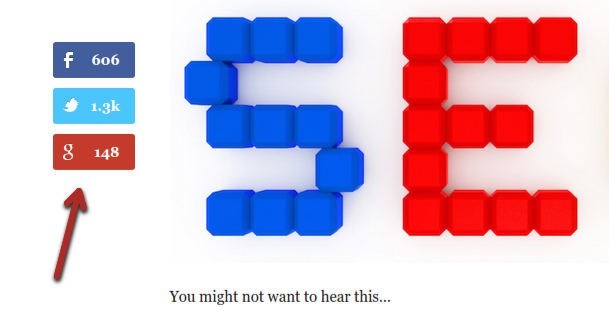
If you’ve been following my nutrition case study site, I (and Mike) am only focusing on one single network—Facebook.
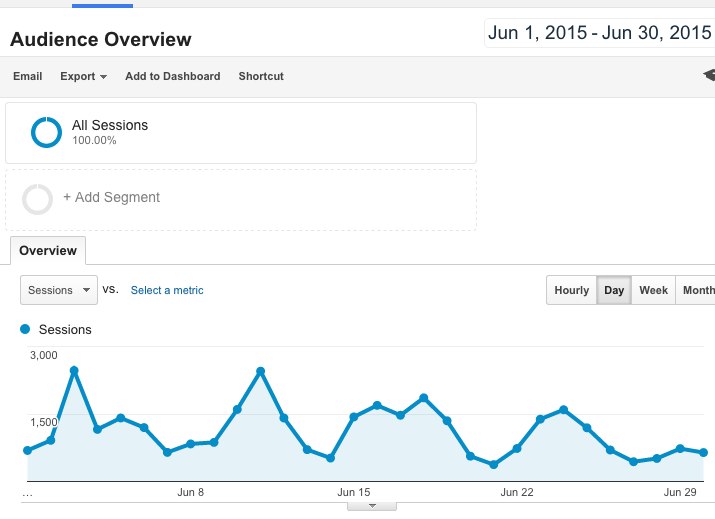
If you’ve been following along, you know that almost all our initial traffic came from Facebook. Clearly, social media can drive massive traffic if you apply the right strategy to leverage it.
So, how do you pick the right network(s) to focus on?
You can use a few different methods to figure that out.
Option 1 – Spy on your competition: In 99.9% of niches, you’ll have some sort of competition already established.
Pick one (or a few) of your competitors, and plug their domain into Buzzsumo’s top content tool:

Even with a free account, this will bring up five or so results of the most shared content on your competitor’s site.
It should be sorted by “total shares” by default (see the down arrow under the heading), but click that heading if it isn’t.
Now, look at the top results, and see which networks are responsible for most of the shares.
In the above case, over 90% of the shares came from Facebook. When a network is that dominant, you can focus on that single network.
As a general rule, if a network is contributing 25%+ of the shares, it’s probably worth focusing on.
Since there can be anomalies when you’re only looking at one site, you can enter other competitors to double-check.
Alternatively, type a relevant keyword into the tool. In this case, I typed in “healthy eating”:
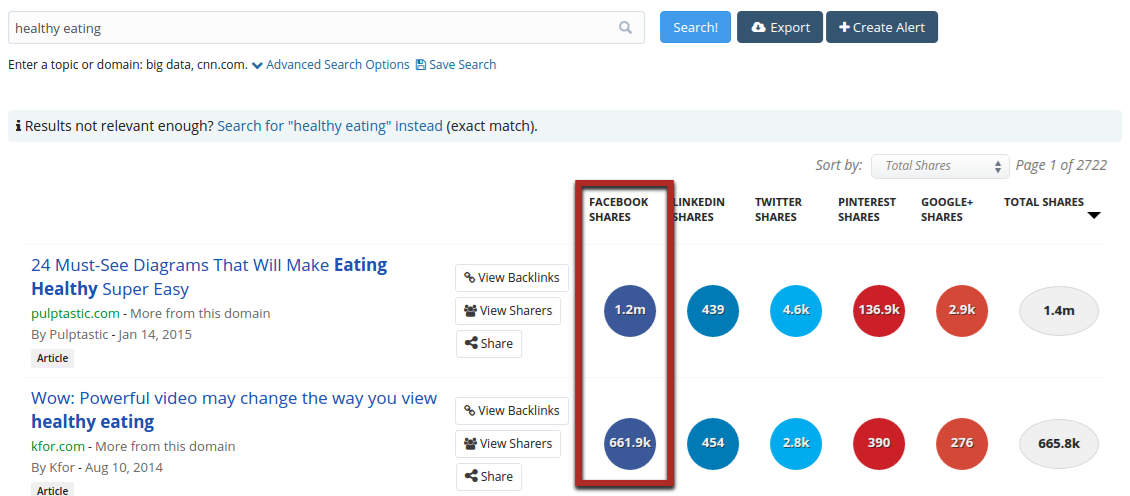
As expected, I saw the same results. Facebook shares dwarfed other networks for all top results.
Option 2 – Pick a channel based on demographics: Another method to determine which social network you should utilize is to look at the demographics of your audience such as:
- age
- gender
- income
- education
- location
Here’s a guide to finding the demographics of your audience.
Since we know what the demographics of each social channel are, you can find a network that matches your audience:
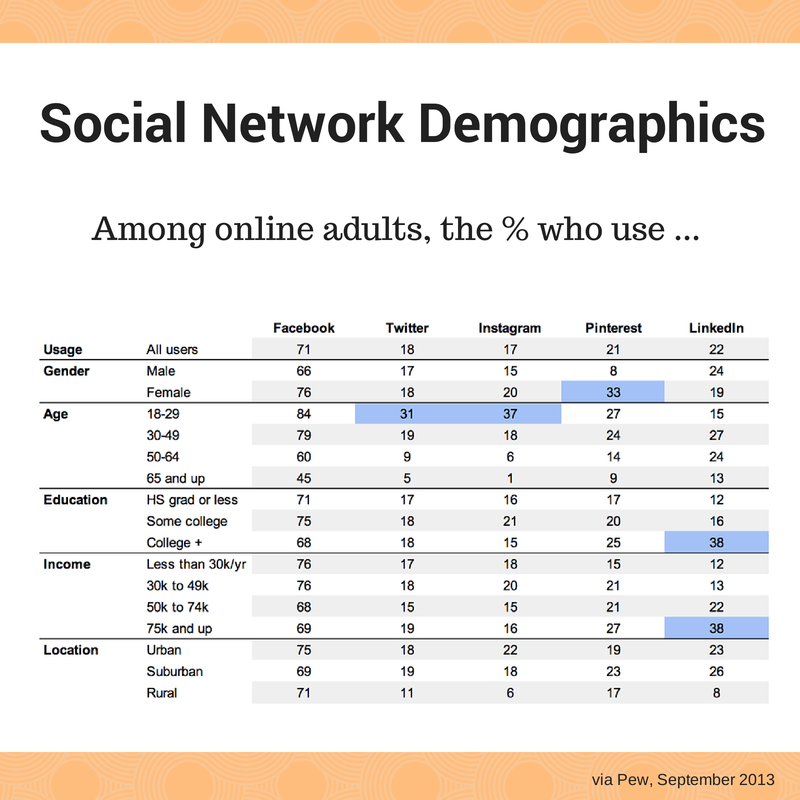
Obviously, you can always play it safe by sticking with Facebook, but if you have a business that’s focused on highly educated high income individuals, you might want to consider LinkedIn as a better choice.
Option 3 – Pick a channel based on content type: Finally, you can pick the right social network to focus on depending on the content you plan to produce.
If you’re an artist or decorator working within a predominantly visual niche, you want to use a platform that is also mostly visual.
Different networks support different content types:

Depending on your niche, the network that’s best for you might be different from that of your competitors. That’s why, if you’re using method #1, you need to pick a close competitor.
For example, a nutrition site might focus on recipes—highly visual. Pinterest, Instagram, and Facebook are all good choices.
Another nutrition site, such as the case study site, might use a combination of text and images. Networks such as Facebook and Google+ are best for it.
Finally, another nutrition site might focus on featuring step-by-step cooking videos. YouTube would be the obvious candidate for that.
4. Create a calendar or face the consequences
Social media is incredibly easy to ignore.
If you miss a few posts here and there, there won’t be any immediate consequence.
But as I said before, consistency is the most important factor when it comes to social media success.
A social media calendar (or schedule) is a necessity if you want to use social media to grow your business.
The calendar will allow you to be consistent, keep on track, and track your results. Tracking your results is needed if you want to determine your progress and ROI.
A social media calendar/schedule can be set up in any way you wish—it’s up to you. But I’ll show you a few different options to help you decide what you want yours to look like.
Option #1 – Use a spreadsheet: Spreadsheets are incredibly versatile, which is why they can work for just about any business.
I’ve seen some incredibly complicated social media calendar spreadsheets…

as well as some simple spreadsheets…
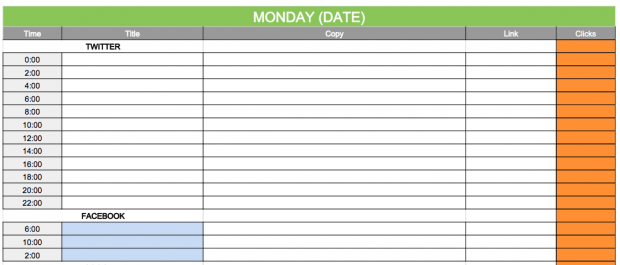
Either one can work well—it depends on how much you utilize social media and how much detail you want to put into it.
With a spreadsheet calendar, you plan everything all at once (batch it!), and then schedule it all at once when you’re done.
Option #2 – Use Buffer: Buffer is an extremely popular social media tool that allows you to schedule posts with minimal effort.
Once you’ve set up an account and are logged in, click on “Schedule.”

Then, click on the main “content” tab. This will allow you to pick a network (on the left). Then, you can type in your share.
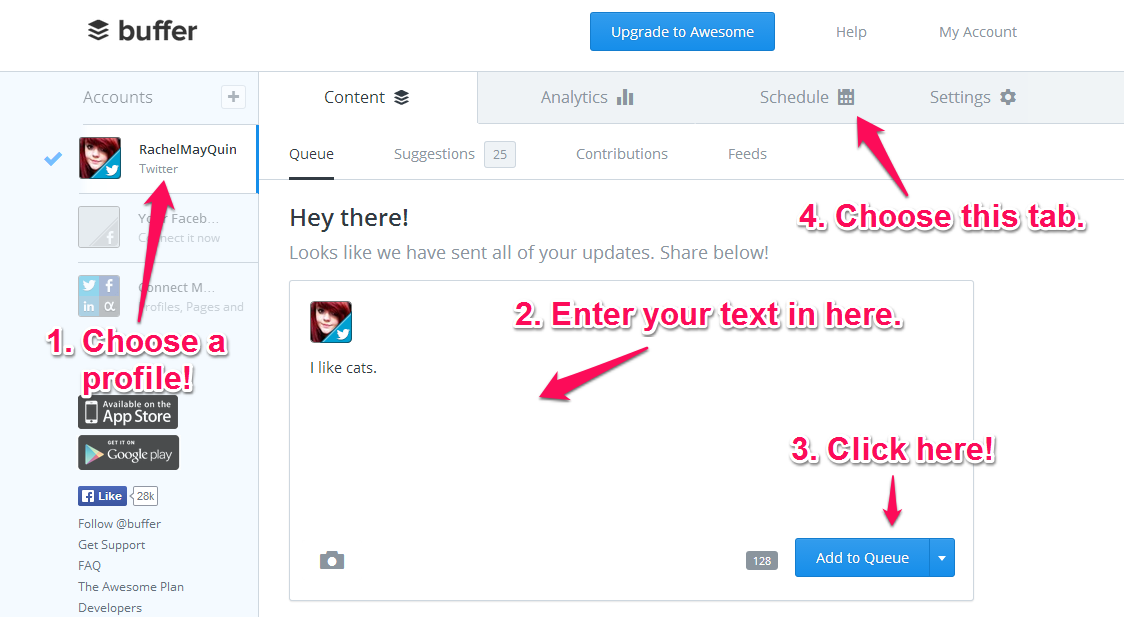
Once you’re done, you can add it to your queue of posts.
You can view your queue at any time and rearrange or edit posts as you like.
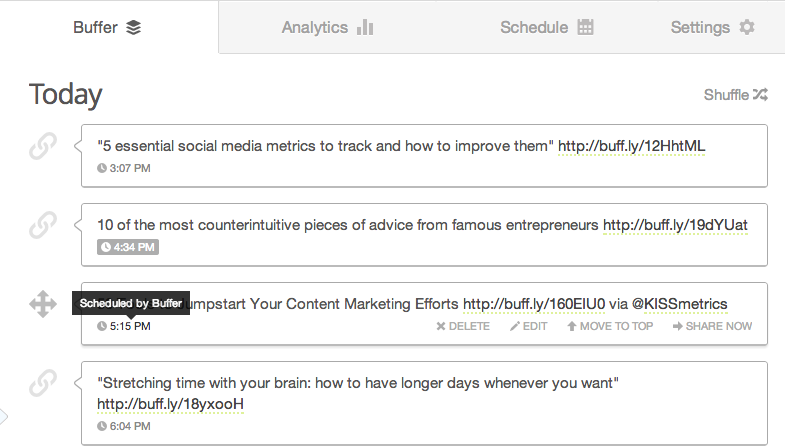
The great thing about Buffer is that once you set those initial posting times, you never have to worry about inputting or missing a date again.
In addition, Buffer works with all the major networks: Facebook, LinkedIn, Twitter, Google+, and Pinterest.
Option #3 – Use Hootsuite: Another option is to use Hootsuite, which used to be the leader in social media tools until Buffer came along.
For the purposes of scheduling, you’ll want to use the bulk schedule option inside Hootsuite:
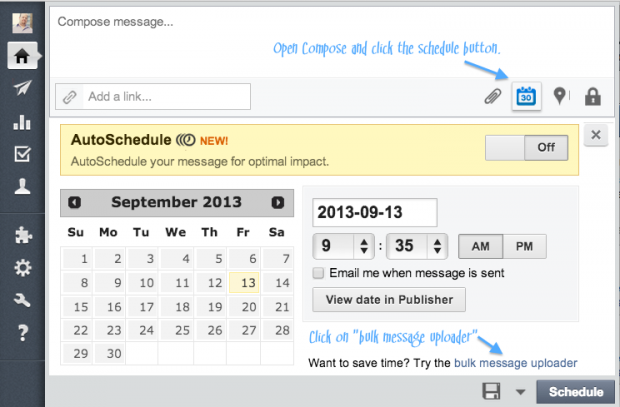
Once you click the “bulk message uploader,” it will ask you to upload a CSV file (a type of spreadsheet).
You will need to create this spreadsheet beforehand.
The spreadsheet must be done in this order: date, message, link. One for each column.
The first column is the trickiest since the date must be written in one of two formats:
dd/mm/yyyy hh:mm OR
mm/dd/yyyy hh:mm
Your default settings for dates will likely be different from the required ones, so you will need to change them.
If you’re using Google Docs, you need to highlight the first column and then navigate to:
“Format > Number > More Formats > More date and time formats”

That will bring up a pop-up.
Use the small dropdown arrow (in the picture below) to pick each date element (day, month, etc.) in the correct order:
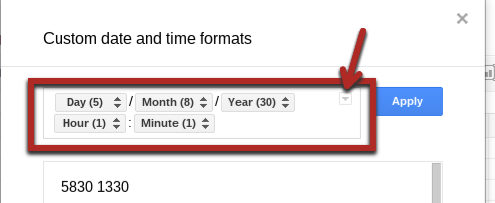
You will need to add a single “/” between the day, month, and year, and a single space between the year and the hour. Finally, put a colon between the hour and the minute fields.
When you’re done, click apply, and the changes will be made.
From here, it gets much easier. Enter your message (complete with hashtags) into the next column.
Finally, enter the corresponding links in the last column. It could be a full URL or a shortened one:

The main downside of this tool is that you can’t add pictures to the posts in the bulk uploader. Posts with pictures on Facebook get 53% more likes than those without. It varies based on the network, but in genearal, images help boost engagement by a significant amount.
Option #4 – Use CoSchedule: A final tool you can use is CoSchedule, which integrates perfectly with WordPress and is simple to use.
Click on the “Calendar” menu option in your admin dashboard once you’ve installed it:

It shows you a typical calendar, but on top of that, it lets you see when you have social media shares scheduled (which will happen automatically).
You can click on a day to enter a status update and move it to a different day by clicking and dragging if needed:
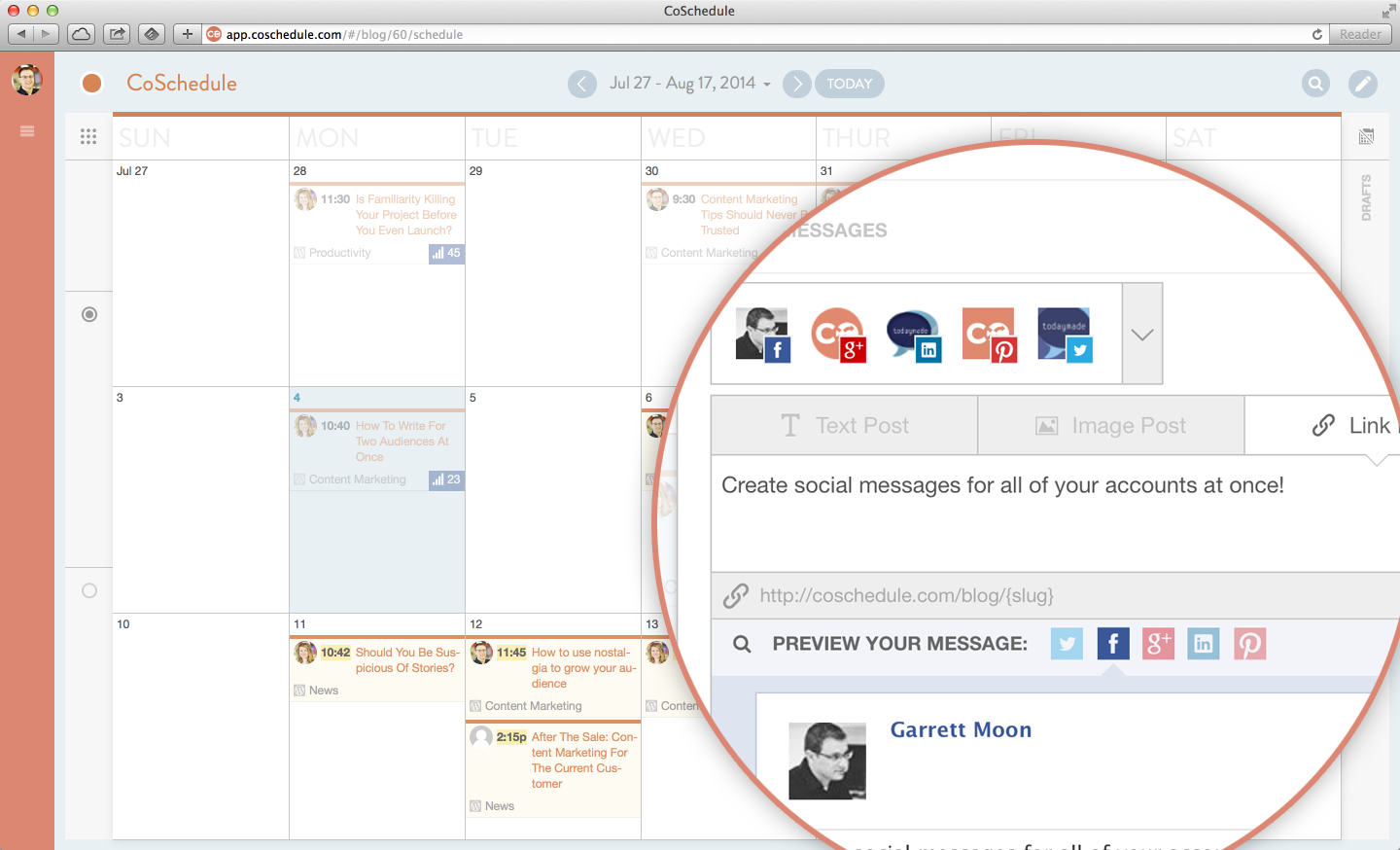
5. Monitor mentions with tools
Instead of messing around with each individual network, you can use tools to find when a reader or customer mentions you.
Usually, these are important messages to reply to, so it’s a good idea to monitor them and then address them all in your scheduled sessions for social media.
Option #1 – Search your brand with Mention.com: This tool is similar to Google Alerts but focuses on social media.
Once you create an account, you enter a keyword (such as your brand name), and it will automatically monitor social media sites for any mentions.
You can set it to send you a daily email of the results:
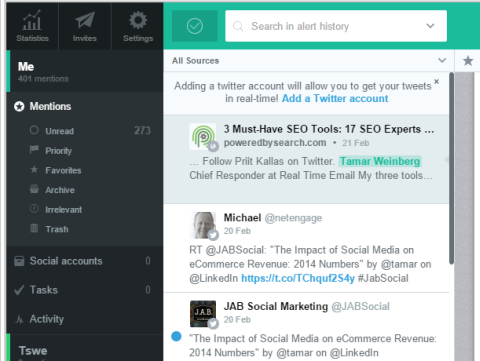
Option #2 – Have mentions monitored automatically with Hootsuite: One thing that Hootsuite is still well known for is monitoring mentions.
You can add keywords to any individual network, and it will monitor your mentions:

You can then see a live stream of all your mentions for keywords or your username in your main Hootsuite dashboard:
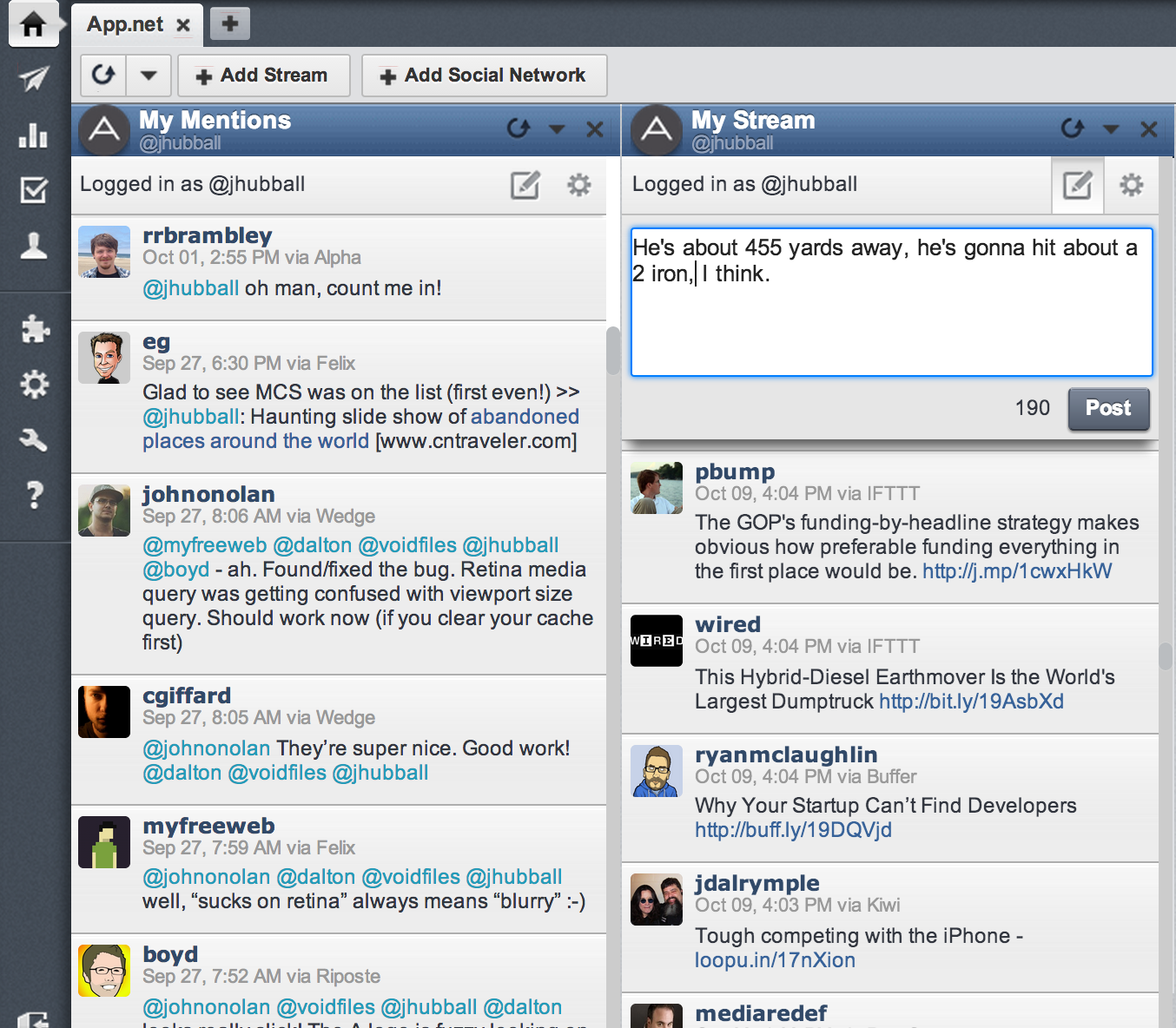
Bonus – get email alerts of Reddit mentions: Reddit isn’t always considered a social media site, but more and more marketers are recognizing its potential. If you’re not familiar with Reddit, refer to my guide to marketing on Reddit.
Most social media tools don’t work with Reddit. But there is a way for you to get an email any time someone mentions a keyword on the site (your brand name or a keyword).
This requires the use of a free tool called IFTTT, which stands for “If This, Then That.”
On IFTTT, you get to specify the event that occurs (the “this) as well as the action (the “that). It can be used to automate processes.
In this case, we will have it send you an email (the “that”) whenever a certain word is mentioned (the “this”).
Luckily, you can use this pre-made recipe to set it up quickly.
Once logged into IFTTT, visit that link and click “connect”:

This will open a small window asking for your permission to use information from your Reddit account. Allow this request:

Back on the recipe page, type in your trigger word. In my example below, I want to be alerted any time someone mentions “quicksprout.com”. There’s a link right below that text field that will help you search for other things other than site names.
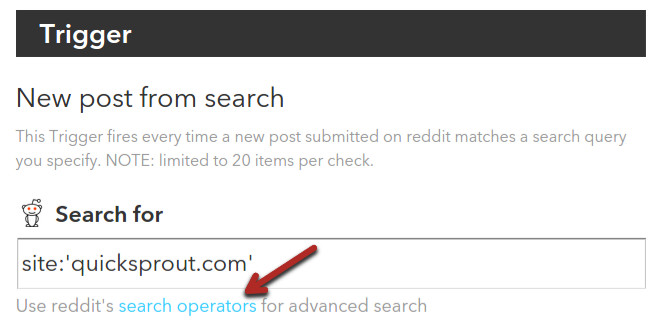
Finally, click “add” at the very bottom to activate the recipe.

And you’re done!
6. Templates are the cornerstone of efficiency
A lot of social media work is repetitive.
You’ll start to see that most top posts look the same and that most of your posts fall under only a few categories.
A lot of tedious work can be avoided by using templates.
Automate reports with a social media report template: If you have a boss to report to or regular meetings where you examine social media results, it’s a good idea to create a social media report template.
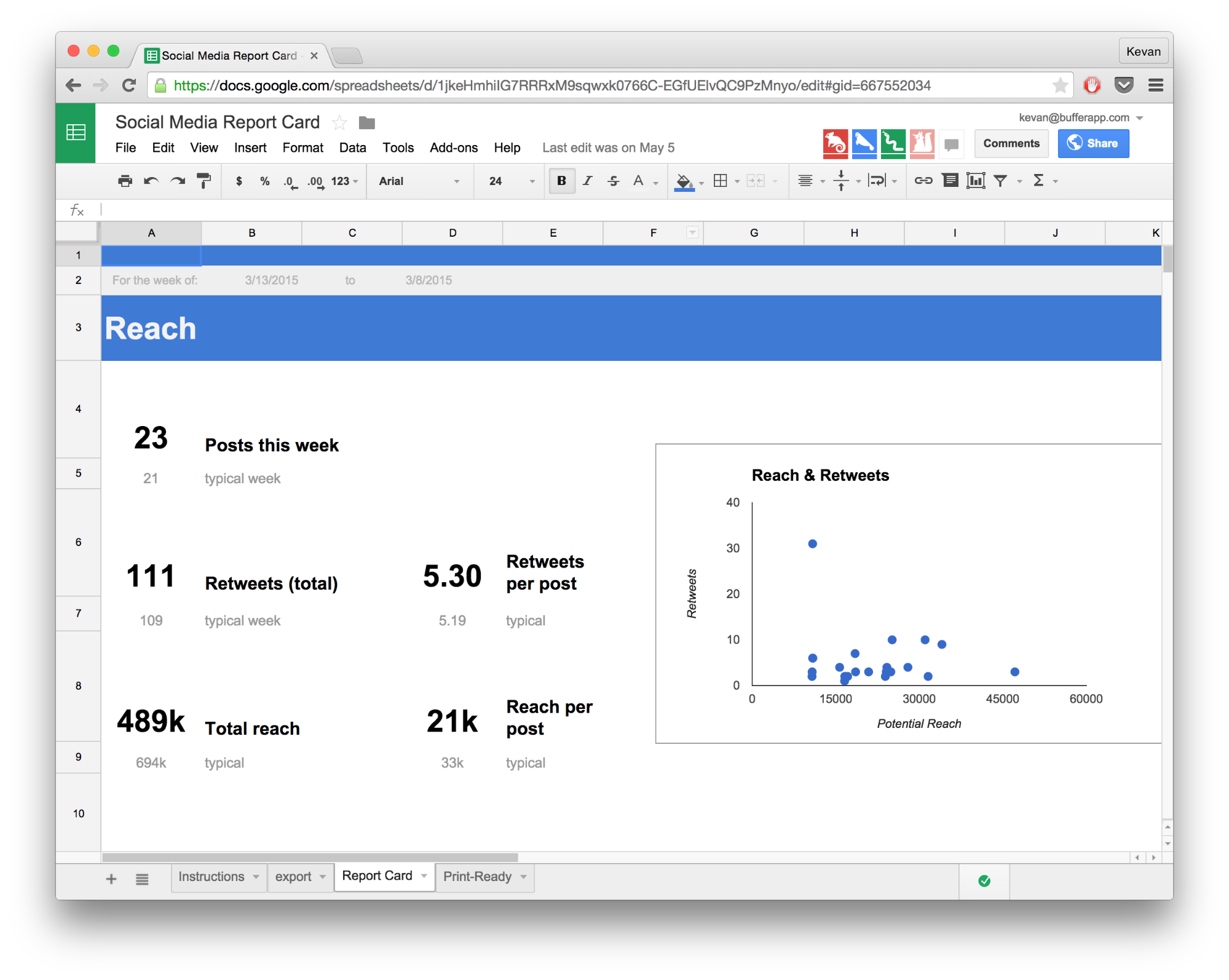
This template should summarize your activity on social media as well as the results for a certain time period. If you like the one above, Buffer has generously shared it free.
Use headline formulas to compose posts faster: I’ve written several times on the topic of creating powerful headlines.
While headlines are usually most important for blog posts, you also need to write enticing headlines so that your other social media posts get a good level of engagement.
Instead of trying to come up with magical headlines every time you work on your social media post ideas, you can reuse successful headline templates.
Here are a few examples of what I mean by headline formulas:
- The secret of _____
- What you need to know about ______
- How to do _____
- ___ ways to do _____
Once you have a good list of formulas, you can easily write 10-20 social media post headlines in a minute.
Here are a few good sources for headline formulas:
- 10 Sure-Fire Headline Formulas That Work
- 30+ Ultimate Headline Formulas for Tweets, Posts, Articles, and Emails
Create visual templates in Canva: You need to use images on almost every social network if you want to get a high level of engagement.
But instead of hiring a designer or creating a picture from scratch, you can use templates specifically made for social media already in Canva.
When you log in, you’ll see many different template options. While you can create a picture from scratch (“use custom dimensions”), it’s easier to pick a template for your social network of choice.

Once you click the type of picture you want to make, a new canvas will be made that’s the right size for your network:
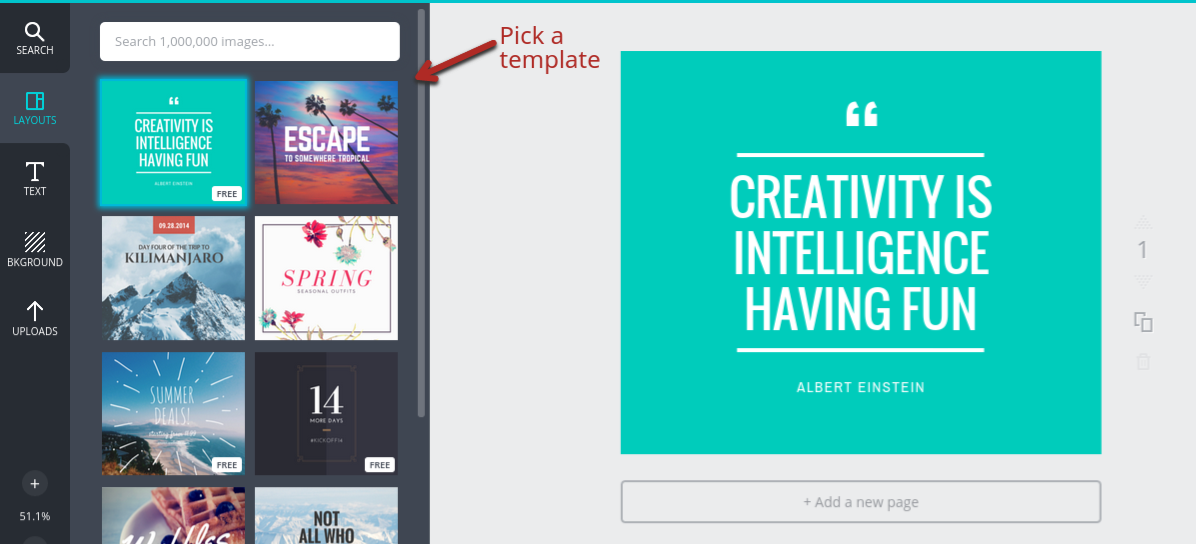
The layouts window on the left will be selected by default.
Pick any template you want, and it will load on the canvas on the right.
From there, you can click on any of the picture elements (background, text, symbols, etc.) and edit them as you like:

Once you’re done, click “download” from the top menu bar.
Once you’re used to this, you can create great looking pictures in under 2 minutes. If you batch your image creation (highly recommended), you can finish all your pictures for the month in under a few hours.
Conclusion
A strong social media presence can be a valuable asset for almost any business.
However, just like with any other part of your business, you need to make sure that it delivers a reasonable ROI on your time and resources.
If you’re wasting many hours a week aimlessly wandering in the jungle of social media, you will not be able to achieve a sustainable ROI.
Use the different methods I’ve shown you in this article to streamline your social media activities, and you’ll find that you only need a few hours per week to manage your social media accounts.
On top of that, you’ll probably start seeing better results once you’re crystal clear on your goals and purpose.
In order to further help you cut back on the number of hours you are spending on social sites, I’ve also created an infographic that will teach you how to be more productive on the social web.

from Quick Sprout https://ift.tt/3gPGOTd
via IFTTT
